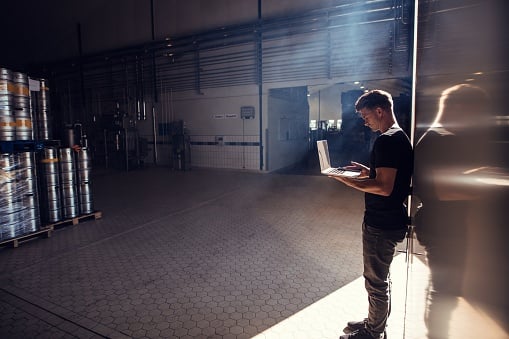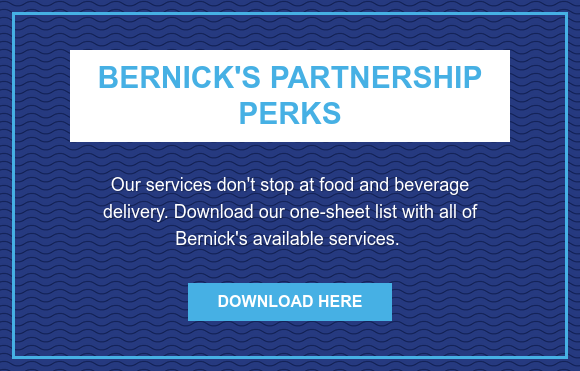When it comes to beverages consumers find on retail shelves, there's hardly any backstory taken into consideration during the purchase decision. After all, that's not the job of the consumer to wonder where the products come from or if there's an origin story attached to it. That job falls on the retailer itself to ensure the products are where they need to be each and every day to keep that supply chain moving. And, those retailers are our customers. Our DSD model—direct store delivery—ensures retailers have those beverages consumers want. The origin story is on us.
Direct Store Delivery (DSD) is a distribution method in the food and beverage industry where products are delivered directly from the manufacturer or supplier to the retail location without going through a central distribution center or warehouse. This approach is common in industries where freshness, timely restocking, and close customer relationships are crucial.
Progressively, companies are looking for ways to keep up with evolving market demands while reducing operating expenses, and more distribution methods are being explored. Recent decades have seen retailers of all sizes take a more active role in controlling their supply chain. One of the most common trends retailers are leveraging is the concept of direct store delivery.
What is Direct Store Delivery?
Direct store delivery (DSD) is a term for delivering products through a full-service distributor. This process, which bypasses the retailer's distribution center, is efficient and ideal for high-demand products. In the grocery industry, DSD accounts for over half of retail profits. This model ensures greater control over retail shelf space, which improves sales and profit margins for retailers.
Direct store delivery according to MWPVL International, "... is the term used to describe a method of delivering product from a supplier/distributor directly to a retail store, thereby bypassing a retailer's distribution center. DSD products are typically, but not always, fast-turning, high velocity, and high consumer demand merchandise."
Key Characteristics of Direct Store Delivery (DSD):
- Direct Shipping: With DSD, products are shipped straight from the manufacturer, producer, or supplier to the retail store. This bypasses traditional warehousing and distribution center stages.
- In-Store Merchandising: In many cases, DSD includes merchandising services. This means that the delivery personnel are responsible for stocking shelves, arranging displays, and managing inventory within the store.
- Close Customer Relationships: DSD creates a direct relationship between the supplier and the retailer. This close connection allows for quicker feedback, customized merchandising, and more responsive service.
- Frequent Deliveries: DSD typically involves frequent deliveries, often several times a week or even daily. This ensures that products are consistently available, reducing the risk of stockouts.
- Responsibility for Stock Levels: The DSD provider is often responsible for monitoring stock levels in the store, ensuring products are replenished as needed, and removing outdated or unsold items.
At Bernick's, DSD is our business model. Boiled down, it means we handle the product category for customers from beginning to end. The customer doesn't have to worry about ordering, warehousing, inventory, merchandising, or unloading any of our products. As far as categories go, any and all liquid refreshment beverages pertain.
Overseeing pricing and promotions, in addition to providing DSD, distributors often provide value-added services, including:
- Shelf inventory management
- Store ordering
- In-store merchandising
- In-store forecasting
Direct store delivery is the ideal distribution model for perishable items because it greatly reduces the time products spend in the supply chain. This ensures less waste, as well as a higher profit margin for the retailer.
Team Approach
DSD is more service-driven than it is portfolio-driven, though we take great pride in the brands we carry. It’s really about the business model.
For illustration, we have nearly 700 team members. If we used a warehouse model, we’d need a third of those people. Warehouse delivery is about picking by pallet; Bernick’s picks by case. It takes a team and careful planning and orchestrating to maintain a successful business model. Day in and day out, we've got people in the system fully vested in the work we do. It takes everyone.
This is how we add value to our customers. Sometimes I believe we take it for granted. "It’s just what we do" can be the mentality and as the business gets more competitive (and our customers see more competition within their industries as well), it’s critical that we continue to foster the value we add to our process. It’s easy to fill the shelves, right?
It’s more difficult to understand our customers’ unique challenges or pain points and devise a solution for each. If our model suddenly or gradually becomes an order-taking mechanism to fill shelves or replenish inventory, that looks a lot like the warehouse model. We lose the opportunity to look at each customer’s industry and store as individual components of the business.
Benefits of Direct Store Delivery
The opposite of DSD is the warehouse system. It's a drop-and-go transaction where a product is delivered en masse to loading docks and warehouses. The onus is then on retailers and stores to get the product onto shelves and floors. Those stores are tasked with ordering, forecasting, unloading, inventory, and marketing. Think of the manpower in that equation. The store personnel then handles the stocking, displays, POS, merchandising, and inventory that’s necessary. Grocery stores can be strapped, and often faced with labor challenges within that industry.
- Fresher Products. Because DSD avoids intermediate warehousing, products tend to be fresher, which is especially important for perishable items like dairy, bakery goods, and beverages.
- Reduced Handling. Direct delivery reduces the number of times products are handled, lowering the risk of damage or spoilage.
- Increased Flexibility. Retailers can quickly adjust to changing consumer demands since DSD providers can adapt their deliveries to meet evolving needs.
- Enhanced Merchandising. DSD often involves supplier-managed merchandising, ensuring that products are displayed attractively and effectively within the store.
- Better Inventory Management. The direct relationship between the DSD provider and retailer facilitates real-time inventory management, leading to more accurate stock levels and reduced waste.
- Cost Savings. While DSD can involve additional transportation and labor costs, it can lead to overall cost savings through reduced warehousing needs, fewer stockouts, and less waste from outdated products.
Our goal is to add value to the customer by managing the entire process so they don’t have to. It’s very important that we put the customer first in this model. It’s really about facilitating success for customers and helping them sell our products. Our products are valuable to consumers, and product placement and looking sharp, and dressing them up is about the trust our customers place upon us within their stores. It’s their territory and turf. If our vision isn’t about their success, we’re doing it wrong. The level of trust we have from store owners, managers, and staff is incredible. They give our team the keys to their stores for accessibility. It’s a lot of responsibility and we strive to live up to that honor and accountability.
In today's retail environment, there are an increasing number of product choices and difficulties managing store-specific product offerings. DSD provides retailers with the opportunity to take charge of their own growth. This model can power sales, improve profit margins, improve the effectiveness of promotions, and build customer loyalty by creating a better shopping experience.
Operating a business is very demanding, and while it is impossible to outsource every job, exploring alternative delivery models can have a great impact in some instances. The DSD model has several benefits for retailers interested in running their businesses more efficiently and having greater control over their merchandise.
Overall, the DSD model drives a better bottom line for the retailer and a superior shopping experience for the customer. Four highlights of this model include:
1. Improved Cycle Times
When products that are supplied by a DSD partner are delivered twice weekly, their replenishment cycle is five times faster than other grocery items. Because the distributor maintains ownership of all upstream inventory, the products generally move much faster and the retailer can commit less working capital to the inventory. Most retailers also experience positive cash flow, because DSD merchandise is likely to turn several times before payment is due to the distributor.
2. Taking the Guesswork Out of Merchandising
As most retailers will tell you, the labor required for merchandising products is a significant expense. Direct store delivery greatly reduces the time and manpower spent on merchandising because it is handled by the distributor, not the retailer. Since DSD products like coffee and energy drinks are among the fastest-moving and most profitable products in most convenience stores, effective merchandising is critical. DSD partners make sense for retailers because the distributor covers upstream costs.
3. Promotional Effectiveness
Many DSD products are impulsive buys purchased by the shopper during every trip; most consumers drink their purchased energy drink, coffee, bottled water, or Pepsi right away. Because of this, trade promotions can have a huge impact on the sales of these types of products. Effective merchandising, combined with promotions, can improve the sales of these profitable products.
4. Pure Partnership
When you contact your distributor, how does that phone call go? If your direct dial brings you to a receptionist, or if a distributor knows you better by your ID number than by your name, you might want to seek better service. When you work with a distributor who knows your name, it’s more likely they’ll also know your business, your customer base, and likely even your goals. A distributor who deserves your business will make communication easy and keep you and your success as a top priority.
Bernick's: Your Direct Store Delivery Solution
Holistically, we understand our customers’ missions, visions, and values and we support their goals. We can co-develop programs that will complement what they’re trying to achieve. Now we’re a partner. Our goal is to have more intimate relationships with our customers instead of transactional ones. From an execution standpoint, we want to differentiate ourselves from other DSD competitors by bringing extra value. We can treat their stores like they're our own. And we do.
Direct Store Delivery is a valuable strategy in the food and beverage industry. It offers benefits in terms of freshness, flexibility, and customer relationships, but it requires careful planning and logistics to be successful.
Bernick's is a DSD partner that does it all. As one of the most innovative distributors regarding merchandising and customer service, we specialize in developing new ways to generate brand awareness. From organizing promotions to managing shelf inventory, we provide the services your business needs for optimal productivity.




